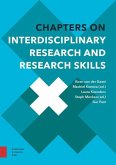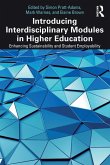Ilja Boor, Debby Gerritsen, Linda Greef
Meaningful Assessment in Interdisciplinary Education
A Practical Handbook for University Teachers
Ilja Boor, Debby Gerritsen, Linda Greef
Meaningful Assessment in Interdisciplinary Education
A Practical Handbook for University Teachers
- Broschiertes Buch
- Merkliste
- Auf die Merkliste
- Bewerten Bewerten
- Teilen
- Produkt teilen
- Produkterinnerung
- Produkterinnerung
In this book, the authors call for an assessment strategy with a greater emphasis on assessment for and assessment as learning, with a focus on giving powerful feedback and the use of authentic assessment tasks as well as alignment with the intended learning outcomes and your pedagogical beliefs.
Andere Kunden interessierten sich auch für
![An Introduction to Interdisciplinary Research An Introduction to Interdisciplinary Research]() Machiel KeestraAn Introduction to Interdisciplinary Research32,99 €
Machiel KeestraAn Introduction to Interdisciplinary Research32,99 €![Chapters on Interdisciplinary Research and Research Skills Chapters on Interdisciplinary Research and Research Skills]() Koen van der GaastChapters on Interdisciplinary Research and Research Skills43,99 €
Koen van der GaastChapters on Interdisciplinary Research and Research Skills43,99 €![The Art of Regenerative Educatorship The Art of Regenerative Educatorship]() Mieke Lopes CardozoThe Art of Regenerative Educatorship32,99 €
Mieke Lopes CardozoThe Art of Regenerative Educatorship32,99 €![Designing Interdisciplinary Education Designing Interdisciplinary Education]() Linda GreefDesigning Interdisciplinary Education32,99 €
Linda GreefDesigning Interdisciplinary Education32,99 €![Interdisciplinary Practices in Higher Education Interdisciplinary Practices in Higher Education]() Interdisciplinary Practices in Higher Education34,99 €
Interdisciplinary Practices in Higher Education34,99 €![Team Teaching and Team Learning in the Language Classroom Team Teaching and Team Learning in the Language Classroom]() Team Teaching and Team Learning in the Language Classroom65,99 €
Team Teaching and Team Learning in the Language Classroom65,99 €![Introducing Interdisciplinary Modules in Higher Education Introducing Interdisciplinary Modules in Higher Education]() Introducing Interdisciplinary Modules in Higher Education46,99 €
Introducing Interdisciplinary Modules in Higher Education46,99 €-
-
-
In this book, the authors call for an assessment strategy with a greater emphasis on assessment for and assessment as learning, with a focus on giving powerful feedback and the use of authentic assessment tasks as well as alignment with the intended learning outcomes and your pedagogical beliefs.
Produktdetails
- Produktdetails
- Perspectives on Inter- and Transdisciplinarity
- Verlag: Amsterdam University Press
- 2 ed
- Seitenzahl: 156
- Erscheinungstermin: 17. Mai 2021
- Englisch
- Abmessung: 244mm x 170mm x 9mm
- Gewicht: 350g
- ISBN-13: 9789463729048
- ISBN-10: 9463729046
- Artikelnr.: 61964236
- Herstellerkennzeichnung
- Libri GmbH
- Europaallee 1
- 36244 Bad Hersfeld
- gpsr@libri.de
- Perspectives on Inter- and Transdisciplinarity
- Verlag: Amsterdam University Press
- 2 ed
- Seitenzahl: 156
- Erscheinungstermin: 17. Mai 2021
- Englisch
- Abmessung: 244mm x 170mm x 9mm
- Gewicht: 350g
- ISBN-13: 9789463729048
- ISBN-10: 9463729046
- Artikelnr.: 61964236
- Herstellerkennzeichnung
- Libri GmbH
- Europaallee 1
- 36244 Bad Hersfeld
- gpsr@libri.de
Ilja Boor lectures for the Bachelor's program Psychobiology and is project leader Educational Innovation at curriculum level at the Teaching & Learning Center of the Faculty of Science of the University of Amsterdam, the Netherlands. Debby Gerritsen lectures for the Bachelor's program Interdisciplinary Social Science and the interdisciplinary Research Master's Social Sciences at the University of Amsterdam, the Netherlands. Linda de Greef works at the Institute for Interdisciplinary Studies at the University of Amsterdam. She is the programme manager at The Teaching Lab where experiments, publications, workshops, guides and methods for interdisciplinary education are developed and shared. Jessica Rodermans until recently designed and organized interdisciplinary electives, honours courses and minor programs for the Institute for Interdisciplinary Studies at the University of Amsterdam, the Netherlands.
Acknowledgments
Introduction
Why this handbook?
Structure of this handbook
Part 1 Getting started with the assessment of interdisciplinarity
Meaningful assessment
Assessing with the right purpose in mind
Providing powerful feedback Making use of authentic assessment
Aligning the assessment with learning outcomes
Aligning the asssessment with pedagogical beliefs and values
Assessing the skills that foster interdisciplinarity
Definitions: multidisciplinary
interdisciplinary
and transdisciplinary
Subskills and learning outcomes
Assessing integration
Assessing critical thinking
Assessing collaboration
Assessing reflection
Part 2 The examples How to navigate the examples 1 Assessing perspective-taking skills with a simulation game
2 Making 'big ideas' tangible with an installation
3 Self-assessment of boundary-crossing competences
4 Peer feedback on the reflection of a stakeholder dialogue
5 Experiencing the learning process using a portfolio
6 A rubric for interdisciplinary capstone projects
7 Making failure a learning tool for collaboration skills
8 Evaluation of the golden principles of collaboration
9 Reflection on teamwork and disciplinary expert roles
10 A moot court to build critical thinking skills
11 Authentic assessment
learning by accident
12 Grading the contributions to class discussions
13 Dance assessment as experiential learning
14 Enhancing critical thinking with Perusall
15 Co-creation of a rubric to encourage ownership of learning
16 Peer and self-assessment for student-led activities
17 From feed-up to feed-forward
18 Comparative judgment as a tool for learning
19 The co-creation of assessment criteria
20 Reflection on interdisciplinary competences using a portfolio
Final remarks: towards new ways of assessment
Lessons learned for meaningful assessment in interdisciplinary education
Taking the next steps
Index
References
Colophon.
Introduction
Why this handbook?
Structure of this handbook
Part 1 Getting started with the assessment of interdisciplinarity
Meaningful assessment
Assessing with the right purpose in mind
Providing powerful feedback Making use of authentic assessment
Aligning the assessment with learning outcomes
Aligning the asssessment with pedagogical beliefs and values
Assessing the skills that foster interdisciplinarity
Definitions: multidisciplinary
interdisciplinary
and transdisciplinary
Subskills and learning outcomes
Assessing integration
Assessing critical thinking
Assessing collaboration
Assessing reflection
Part 2 The examples How to navigate the examples 1 Assessing perspective-taking skills with a simulation game
2 Making 'big ideas' tangible with an installation
3 Self-assessment of boundary-crossing competences
4 Peer feedback on the reflection of a stakeholder dialogue
5 Experiencing the learning process using a portfolio
6 A rubric for interdisciplinary capstone projects
7 Making failure a learning tool for collaboration skills
8 Evaluation of the golden principles of collaboration
9 Reflection on teamwork and disciplinary expert roles
10 A moot court to build critical thinking skills
11 Authentic assessment
learning by accident
12 Grading the contributions to class discussions
13 Dance assessment as experiential learning
14 Enhancing critical thinking with Perusall
15 Co-creation of a rubric to encourage ownership of learning
16 Peer and self-assessment for student-led activities
17 From feed-up to feed-forward
18 Comparative judgment as a tool for learning
19 The co-creation of assessment criteria
20 Reflection on interdisciplinary competences using a portfolio
Final remarks: towards new ways of assessment
Lessons learned for meaningful assessment in interdisciplinary education
Taking the next steps
Index
References
Colophon.
Acknowledgments
Introduction
Why this handbook?
Structure of this handbook
Part 1 Getting started with the assessment of interdisciplinarity
Meaningful assessment
Assessing with the right purpose in mind
Providing powerful feedback Making use of authentic assessment
Aligning the assessment with learning outcomes
Aligning the asssessment with pedagogical beliefs and values
Assessing the skills that foster interdisciplinarity
Definitions: multidisciplinary
interdisciplinary
and transdisciplinary
Subskills and learning outcomes
Assessing integration
Assessing critical thinking
Assessing collaboration
Assessing reflection
Part 2 The examples How to navigate the examples 1 Assessing perspective-taking skills with a simulation game
2 Making 'big ideas' tangible with an installation
3 Self-assessment of boundary-crossing competences
4 Peer feedback on the reflection of a stakeholder dialogue
5 Experiencing the learning process using a portfolio
6 A rubric for interdisciplinary capstone projects
7 Making failure a learning tool for collaboration skills
8 Evaluation of the golden principles of collaboration
9 Reflection on teamwork and disciplinary expert roles
10 A moot court to build critical thinking skills
11 Authentic assessment
learning by accident
12 Grading the contributions to class discussions
13 Dance assessment as experiential learning
14 Enhancing critical thinking with Perusall
15 Co-creation of a rubric to encourage ownership of learning
16 Peer and self-assessment for student-led activities
17 From feed-up to feed-forward
18 Comparative judgment as a tool for learning
19 The co-creation of assessment criteria
20 Reflection on interdisciplinary competences using a portfolio
Final remarks: towards new ways of assessment
Lessons learned for meaningful assessment in interdisciplinary education
Taking the next steps
Index
References
Colophon.
Introduction
Why this handbook?
Structure of this handbook
Part 1 Getting started with the assessment of interdisciplinarity
Meaningful assessment
Assessing with the right purpose in mind
Providing powerful feedback Making use of authentic assessment
Aligning the assessment with learning outcomes
Aligning the asssessment with pedagogical beliefs and values
Assessing the skills that foster interdisciplinarity
Definitions: multidisciplinary
interdisciplinary
and transdisciplinary
Subskills and learning outcomes
Assessing integration
Assessing critical thinking
Assessing collaboration
Assessing reflection
Part 2 The examples How to navigate the examples 1 Assessing perspective-taking skills with a simulation game
2 Making 'big ideas' tangible with an installation
3 Self-assessment of boundary-crossing competences
4 Peer feedback on the reflection of a stakeholder dialogue
5 Experiencing the learning process using a portfolio
6 A rubric for interdisciplinary capstone projects
7 Making failure a learning tool for collaboration skills
8 Evaluation of the golden principles of collaboration
9 Reflection on teamwork and disciplinary expert roles
10 A moot court to build critical thinking skills
11 Authentic assessment
learning by accident
12 Grading the contributions to class discussions
13 Dance assessment as experiential learning
14 Enhancing critical thinking with Perusall
15 Co-creation of a rubric to encourage ownership of learning
16 Peer and self-assessment for student-led activities
17 From feed-up to feed-forward
18 Comparative judgment as a tool for learning
19 The co-creation of assessment criteria
20 Reflection on interdisciplinary competences using a portfolio
Final remarks: towards new ways of assessment
Lessons learned for meaningful assessment in interdisciplinary education
Taking the next steps
Index
References
Colophon.








